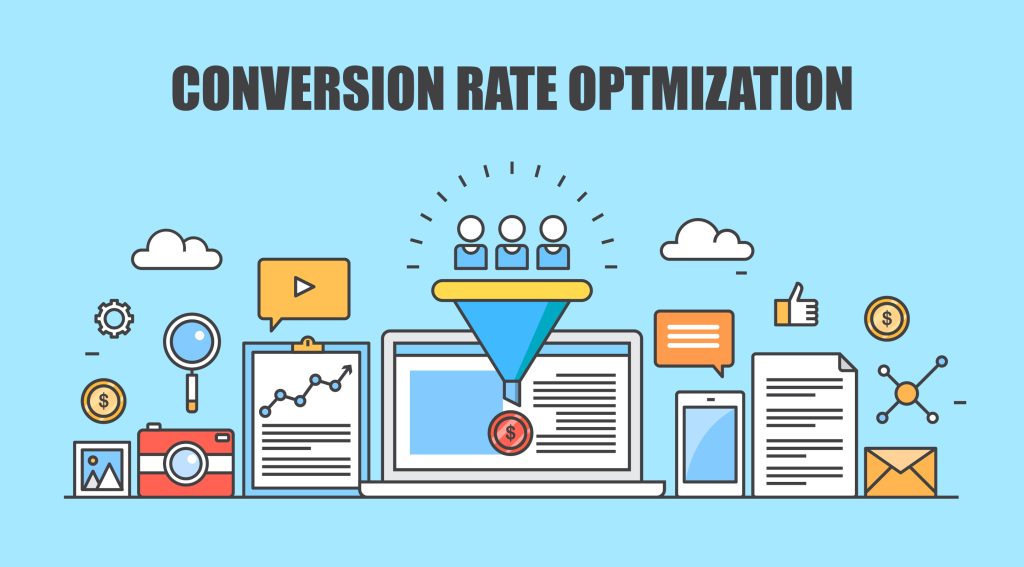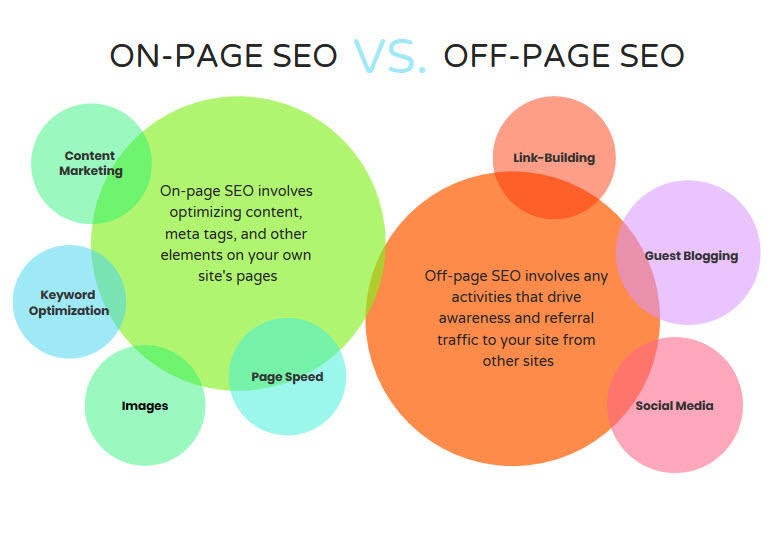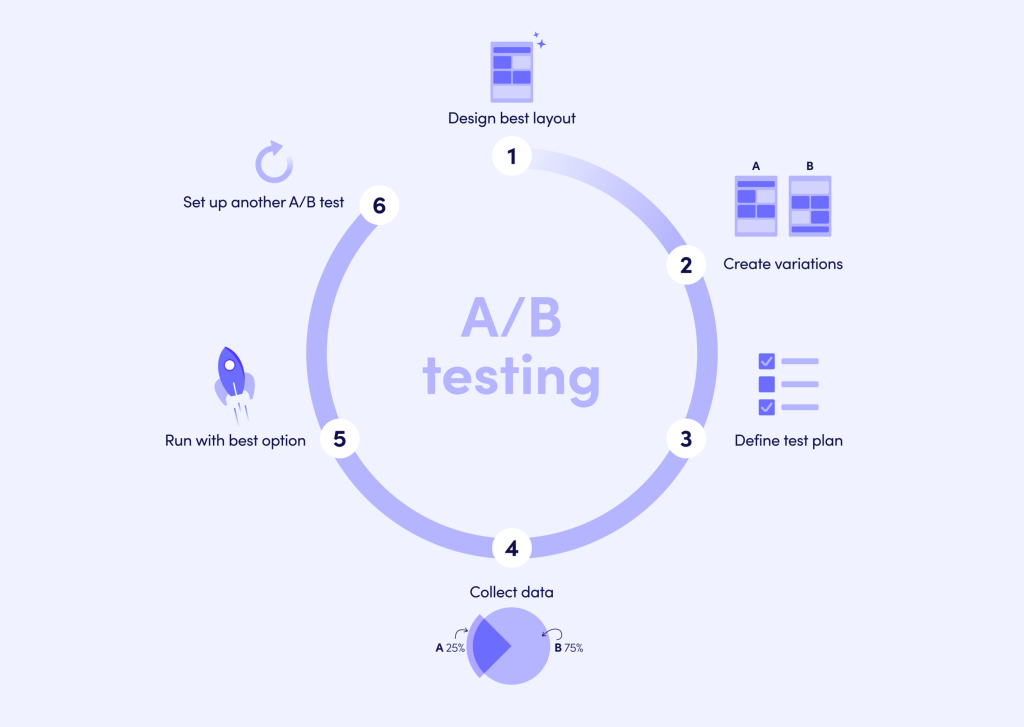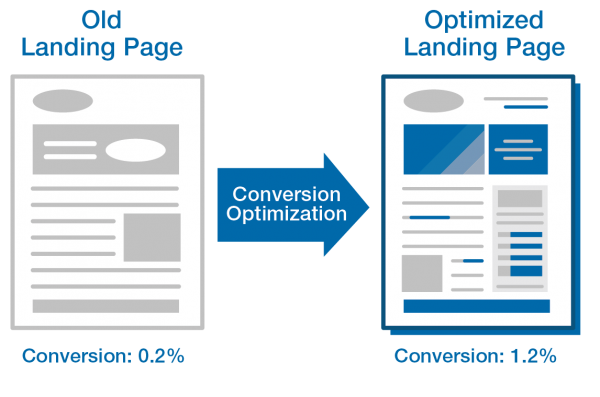Building Websites with a Focus on SEO and Conversion Optimization
Introduction
The importance of SEO and conversion optimization
Search Engine Optimization (SEO) and Conversion Optimization are two critical aspects of website development that work together to improve a website’s visibility and its ability to drive user engagement, traffic, and conversions.

SEO is optimizing a website to improve its ranking and visibility in search engine results pages (SERPs). Higher rankings in SERPs lead to increased website traffic and exposure, ultimately resulting in higher business conversions, sales, and revenue.
Conversely, conversion optimization is the process of optimizing a website to improve its ability to convert visitors into customers or users. This involves designing the website to guide users toward taking specific actions such as filling out a form, purchasing, or subscribing to a newsletter.
Combining SEO and Conversion Optimization in website development ensures that a website attracts the right audience and converts them into customers or users. By focusing on SEO and Conversion Optimization, businesses can build websites that are visually appealing and strategically designed to achieve their business goals.
How the website development process can integrate these aspects
The website development process can integrate SEO and Conversion Optimization in several ways.
Firstly, during the planning phase, businesses can work with their website development team to identify their target audience and the keywords they will likely use when searching for products or services. This helps create an SEO strategy that optimizes website content, meta descriptions, title tags, and other on-page elements to improve visibility and search engine rankings.
During the design phase, Conversion Optimization techniques can be incorporated by designing the website to provide a clear and intuitive user experience that guides visitors toward desired actions. This involves optimizing the website’s layout, navigation, calls-to-action, and other design elements to create a seamless user journey.
In the development phase, SEO best practices can be implemented by creating a mobile-responsive website that loads quickly and meets search engine standards for website performance. Conversion Optimization can also be integrated by building landing pages optimized for user engagement and designed to increase conversions.
Finally, ongoing maintenance and optimization are critical to ensuring that the website continues to meet SEO and Conversion Optimization goals. Regular website updates, A/B testing, and analytics tracking are essential to measure and optimize website performance over time.
By integrating SEO and Conversion Optimization throughout the website development process, businesses can create websites that look good and achieve their business goals by attracting and converting the right audience.
SEO-focused Website Design
Factors to consider when designing a website for SEO
There are several factors to consider when designing a website for SEO. Here are some of the most important ones:
- Keyword Research: Researching the keywords and phrases your target audience is searching for is crucial for SEO. Keyword research helps understand the user’s intent and design website content around the keywords most relevant to your business.
- Content Structure: How website content is structured is crucial in SEO. Organizing content into clear and concise sections with headings, subheadings, and bullet points makes it easier for search engines to understand the website and index it accordingly.
- Title Tags and Meta Descriptions: Title tags and meta descriptions are HTML elements that provide information about the website to search engines. Including relevant keywords in these elements can improve the website’s ranking in search engine results pages.
- URL Structure: The structure of the website’s URLs can also impact SEO. Creating clean and concise URLs with relevant keywords can make it easier for search engines to understand the page’s content.
- Mobile Responsiveness: Mobile responsiveness is crucial for SEO as search engines prioritize mobile-friendly websites in search results. A mobile-responsive website ensures that the website is accessible and easy to use on all devices.
- Page Loading Speed: Page loading speed is critical for SEO as slow-loading pages can negatively impact user experience and search engine rankings. Optimizing page loading speed by compressing images, reducing server response time, and minimizing HTTP requests can improve SEO performance.

By considering these factors when designing a website for SEO, businesses can create optimized websites for search engines, provide a great user experience, and drive traffic and conversions.
Best practices for on-page optimization, including keyword research, meta tags, and content structure
On-page optimization is a crucial aspect of SEO, and there are several best practices to follow to ensure that a website’s content is optimized for search engines. Here are some of the most important ones:
- Keyword Research: Conducting keyword research helps identify the most relevant keywords and phrases to target in the website’s content. Keywords should be used naturally throughout the content and in headings, subheadings, and meta descriptions.
- Title Tags and Meta Descriptions: Title tags and meta descriptions are HTML elements that provide information about the website to search engines. Including relevant keywords in these elements can improve the website’s ranking in search engine results pages. Title tags should be concise and descriptive and include the most important keywords. Meta descriptions should summarize the page’s content and include relevant keywords.
- Content Structure: Organizing content into clear and concise sections with headings, subheadings, and bullet points makes it easier for search engines to understand what the website is about and index it accordingly. Content should also be easy to read and provide value to the user.
- Internal Linking: Internal linking refers to linking to other pages within the website. Internal links help search engines understand the hierarchy of content on the website and improve user experience by guiding users to related content. Including relevant anchor text in internal links can also improve the website’s ranking for specific keywords.
- Image Optimization: Images should be optimized by compressing their size without losing quality, adding descriptive alt text, and using relevant file names. This improves page loading speed and makes it easier for search engines to understand the page’s content.

By following these best practices for on-page optimization, businesses can create websites optimized for search engines, provide a great user experience, and drive traffic and conversions.
Importance of mobile responsiveness and page loading speed
Mobile responsiveness and page loading speed is critical for SEO and user experience. Here’s why:
- Mobile Responsiveness: With the increase in mobile device usage, having a mobile-responsive website has become crucial for SEO. Google prioritizes mobile-friendly websites in search results, and websites not optimized for mobile devices may be penalized in rankings. A mobile-responsive website ensures that it is accessible and easy to use on all devices, providing a positive user experience and increasing the likelihood of visitors staying on the website and engaging with its content.
- Page Loading Speed: Page loading speed is another crucial factor for SEO and user experience. Slow-loading pages can negatively impact user experience, leading to higher bounce rates and decreased time on site. This can harm search engine rankings as Google considers user experience signals in its algorithm. Optimizing page loading speed by compressing images, reducing server response time, and minimizing HTTP requests can improve user experience and SEO performance.
Mobile responsiveness and page loading speed is critical for SEO and user experience. A mobile-responsive website ensures that the website is accessible and easy to use on all devices while optimizing page loading speed improves user experience and search engine rankings. By prioritizing these factors, businesses can create websites that look good and provide a positive user experience and drive traffic and conversions.
Conversion Optimization Techniques
Understanding user behavior and the customer journey
Understanding user behavior and the customer journey is essential for creating a website that effectively engages and converts visitors. Here’s an overview of what these terms mean and why they’re important:
- User Behavior: User behavior refers to how users interact with a website. This includes the pages they visit, how long they stay on each page, their actions, and their path through the website. Understanding user behavior helps businesses identify areas of the website that may need improvement, as well as opportunities to increase engagement and conversions.
- Customer Journey: The journey is a potential customer’s path from initial awareness of a product or service to the final decision to purchase. This journey may involve several touchpoints, such as visiting a website, reading reviews, or engaging with customer support. Understanding the customer journey helps businesses identify opportunities to engage potential customers and move them through the sales funnel.
Businesses can create websites that effectively engage and convert visitors by understanding user behavior and the customer journey. This may involve implementing features like clear navigation, easy-to-use forms, and calls to action that guides visitors through the customer journey. It may also involve analyzing user behavior data to identify areas of the website that may need improvement and testing new approaches to optimize the customer journey. Understanding user behavior and the customer journey is critical for creating a website that effectively engages and converts visitors into customers.
Designing clear and concise call-to-actions (CTAs)
A clear and concise call-to-action (CTA) is a crucial element of a website designed to drive conversions. Here are some tips for designing effective CTAs:
- Use Action-Oriented Language: CTAs should use action-oriented language, encouraging users to take a specific action. For example, “Sign Up Now,” “Download Your Free Guide,” or “Get Started Today.”
- Make it Visually Distinct: CTAs should stand out visually from the rest of the page. Using contrasting colors, bold text, or buttons can help make the CTA visually distinct and draw attention to it.
- Keep it Concise: CTAs should be short and to the point. Avoid using long sentences or overly complicated language that may confuse or overwhelm the user.
- Use Urgency or Scarcity: Adding urgency or scarcity to a CTA can encourage users to take action. For example, “Limited Time Offer” or “Only 3 Spots Left.”
- Place it Strategically: CTAs should be placed strategically on the page where users will most likely see them. This may include above the fold, near the end of a blog post, or on a product page.
- Test and Optimize: Testing different variations of CTAs can help businesses identify which ones are most effective. This may involve testing different colors, text, placement, or design elements to see which CTA drives the most conversions.
By designing clear and concise CTAs that are strategically placed and visually distinct, businesses can create websites that effectively guide visitors through the customer journey and drive conversions. Regularly testing and optimizing CTAs can help businesses improve their website’s conversion rate.
Implementing A/B testing to optimize conversion rates

A/B testing, also known as split testing, is a process that involves comparing two versions of a web page to determine which one performs better in terms of driving conversions. Here are the steps involved in implementing A/B testing to optimize conversion rates:
- Identify the Goal: The first step is to identify the goal of the A/B test. This could be to increase clicks on a specific call-to-action, improve form submissions, or increase sales of a particular product.
- Create Variations: Create two web page versions – the original version and a variation that includes changes intended to improve the conversion rate. This could involve layout, design, copy, or call-to-action changes.
- Split Traffic: Split the traffic evenly between the two versions of the page using an A/B testing tool. This allows businesses to compare each page’s performance and determine which is more effective in achieving the desired goal.
- Analyze Results: Analyze the results of the A/B test to determine which page performed better. This may involve tracking metrics like click-through, bounce, and conversion rates.
- Implement Changes: Once a winner is determined, implement the changes on the original web page to improve the conversion rate.
- Repeat the Process: Regularly conduct A/B tests to identify further opportunities to optimize the website and improve the conversion rate.
By implementing A/B testing, businesses can make data-driven decisions to improve their website’s conversion rate. A/B testing can help businesses identify which changes are most effective in improving the customer journey and driving conversions. By regularly testing and optimizing, businesses can create websites that effectively engage and convert visitors into customers.
Strategies for reducing bounce rate and increasing engagement

Bounce rate refers to the percentage of visitors who leave a website after viewing only one page. A high bounce rate can indicate that visitors are not finding what they are looking for on the website or that the website is not engaging enough to keep them interested. Here are some strategies for reducing bounce rate and increasing engagement:
- Improve Page Load Speed: Slow page load times can cause visitors to abandon a website before it fully loads. Optimizing images, using a content delivery network (CDN), and minimizing the use of plugins and scripts can help improve page load speed.
- Improve Website Design: A clean and easy-to-navigate website design can improve the user experience and reduce bounce rates. This may include using clear and concise headlines, bullet points to break up the text, and images and videos to illustrate key points.
- Optimize for Mobile: With more and more people browsing the internet on mobile devices, ensuring the website is optimized for mobile is essential. This may include using responsive design, optimizing images for smaller screens, and using clear, easy-to-click buttons.
- Use Clear and Concise CTAs: Clear and concise call-to-actions (CTAs) can help guide visitors through the customer journey and encourage them to take action. This may include using contrasting colors, bold text, and placing CTAs in prominent locations.
- Improve Content Quality: High-quality and relevant content can help keep visitors engaged and reduce bounce rates. This may include using informative blog posts, adding infographics, and creating videos.
- Use Personalization: Personalizing the user experience can help keep visitors engaged and reduce bounce rates. This may include using dynamic content, showing related products or services, or using personalized recommendations.
By implementing these strategies, businesses can reduce bounce rates and increase engagement on their website. Regularly monitoring website metrics and testing different strategies can help businesses identify areas for improvement and optimize their website for better engagement and conversion rates.
Integrating SEO and Conversion Optimization
Importance of aligning SEO and conversion goals

Aligning SEO and conversion goals is critical for the success of any website. Here are some reasons why it is important to align SEO and conversion goals:
- Improves User Experience: Aligning SEO and conversion goals helps create a user-friendly and engaging website. Optimizing for relevant keywords and ensuring a smooth customer journey makes visitors more likely to stay on the website longer, engage with the content, and ultimately convert.
- Increases Organic Traffic: A well-executed SEO strategy can help drive more organic traffic to a website. By optimizing for relevant keywords and improving the user experience, websites can rank higher in search engine results pages (SERPs) and attract more organic traffic.
- Improves Conversion Rates: Optimizing for conversion goals can help improve a website’s conversion rate. By guiding visitors through a well-designed customer journey and using clear and concise call-to-actions, visitors are more likely to convert into customers.
- Enhances ROI: Aligning SEO and conversion goals can improve a website’s return on investment (ROI). Businesses can generate more revenue from their website by driving more organic traffic and improving the conversion rate.
- Provides Data-Driven Insights: By aligning SEO and conversion goals, businesses can track key metrics and gather data-driven insights about their website’s performance. This can help identify areas for improvement and optimize the website for better engagement and conversion rates.
Overall, aligning SEO and conversion goals is essential for creating a website optimized for search engines and users. By focusing on relevant keywords and a well-designed customer journey, businesses can drive more organic traffic, improve conversion rates, and generate more revenue from their website.
Best practices for optimizing landing pages for both SEO and conversions

Optimizing landing pages for both SEO and conversions requires a careful balance of several factors. Here are some best practices for optimizing landing pages for both SEO and conversions:
- Focus on Relevant Keywords: To optimize landing pages for SEO, it’s important to focus on relevant keywords that align with the page’s content and user intent. Conducting thorough keyword research and using targeted keywords in the page title, meta description, headers, and body content can help improve the page’s relevance and search engine visibility.
- Use Clear and Concise Headlines: The headline of a landing page should be clear and concise and communicate the page’s value proposition. A strong headline can help attract and retain visitors’ attention and encourage them to engage further with the page.
- Optimize Page Speed: Page speed is key to SEO and conversion optimization. Slow-loading landing pages can negatively impact user experience and reduce conversions. Optimizing images, reducing server response times, and minimizing the use of plugins and scripts can help improve page speed.
- Create Compelling Content: High-quality and relevant content can help keep visitors engaged and increase the likelihood of conversions. Use bullet points, images, and videos to make the content more visually appealing and easier to digest. Ensure the content is written to resonate with the target audience and align with the page’s goals.
- Use Clear and Concise CTAs: A clear and concise call-to-action (CTA) is essential for conversion optimization. The CTA should be prominently displayed on the page and use contrasting colors, bold text, and other visual cues to make it stand out. The CTA should also clearly communicate the action that visitors are expected to take.
- A/B Test Different Page Elements: Conducting A/B tests can help identify which page elements are working and which can be improved. Test different headlines, CTAs, images, and other elements to see what works best for the target audience and page goals.
By following these best practices, businesses can optimize their landing pages for both SEO and conversions, resulting in increased organic traffic, improved user experience, and higher conversion rates.
The role of analytics in measuring and improving website performance

Analytics plays a crucial role in measuring and improving website performance. Analytics tools give businesses valuable insights into user behavior, website traffic, and conversion rates. Here are some of the ways analytics can help measure and improve website performance:
- Track Key Metrics: Analytics tools allow businesses to track metrics such as website traffic, bounce rates, conversion rates, and revenue. These metrics provide a clear picture of website performance and help businesses identify areas for improvement.
- Identify User Behavior: Analytics tools can help businesses understand how users interact with their websites. Businesses can see which pages are most popular, how long users spend on each page, and where they drop off in the conversion funnel. This information can be used to optimize the user experience and improve conversion rates.
- Measure Campaign Performance: Analytics tools can track the performance of digital marketing campaigns, such as pay-per-click (PPC) ads and social media campaigns. Businesses can identify which campaigns drive the most traffic and conversions by measuring key metrics such as click-through and conversion rates.
- Optimize Website Design: Analytics tools can provide insights into how users interact with website design elements such as navigation menus, buttons, and forms. By analyzing user behavior, businesses can identify design elements that work well and need improvement.
- Conduct A/B Testing: Analytics tools can be used to conduct A/B testing to identify which design elements and content are driving the most conversions. By testing different variations of landing pages, businesses can optimize their website for better performance.
In summary, analytics tools give businesses the data they need to measure and improve website performance. By tracking key metrics, understanding user behavior, and optimizing website design and content, businesses can improve conversion rates, increase revenue, and achieve digital marketing goals.
Conclusion
Here’s a recap of key takeaways for building websites with a focus on SEO and conversion optimization:
- SEO and conversion optimization are essential for website success as they drive traffic, engagement, and conversions.
- To integrate SEO and conversion optimization into website development, businesses should consider keyword research, meta tags, content structure, mobile responsiveness, page loading speed, and user behavior.
- Best practices for on-page optimization include using relevant keywords, clear and concise headlines, optimized page speed, compelling content, and clear and concise CTAs.
- A/B testing can be used to optimize conversion rates and improve website performance.
- To reduce bounce rates and increase engagement, businesses should consider strategies such as improving website design and user experience, engaging content, and creating clear and concise CTAs.
- Analytics play a crucial role in measuring and improving website performance by providing insights into user behavior, website traffic, conversion rates, and campaign performance.
- To optimize landing pages for both SEO and conversions, businesses should use relevant keywords, clear and concise headlines, optimized page speed, compelling content, clear and concise CTAs, and A/B testing to identify what works best for their target audience.
By incorporating these key takeaways into the website development process, businesses can build websites that drive traffic, engagement, and conversions.
Ongoing website maintenance and optimization are crucial for achieving long-term success for your website. Here are some reasons why:
- Keep Your Website Up-to-Date: Technology and search engine algorithms are constantly evolving, and website maintenance ensures that your website stays up-to-date with the latest trends and standards.
- Improve Website Security: Regular maintenance helps ensure your website is secure and protected against hacking attempts and cyber threats.
- Optimize Website Performance: Ongoing optimization helps improve website speed and overall performance, improving user experience and search engine rankings.
- Enhance User Experience: Website maintenance can improve user experience by fixing broken links, updating content, and ensuring the website is easy to navigate.
- Increase Conversion Rates: Ongoing optimization can help to improve conversion rates by optimizing landing pages, CTAs, and forms and conducting A/B testing to identify what works best for your target audience.
- Measure and Analyze Performance: Regular analytics and performance monitoring can help you identify areas for improvement and make data-driven decisions to optimize your website.
In summary, ongoing website maintenance and optimization are essential for long-term success. By keeping your website up-to-date, improving website security, optimizing website performance, enhancing user experience, increasing conversion rates, and measuring performance, you can ensure that your website remains competitive and effective over time.
Certified Laravel Developer
Certified Laravel Developer